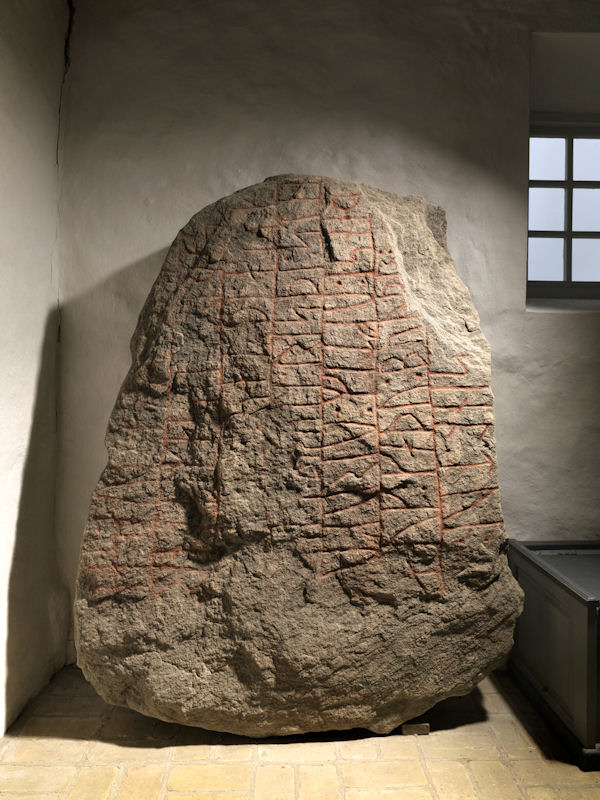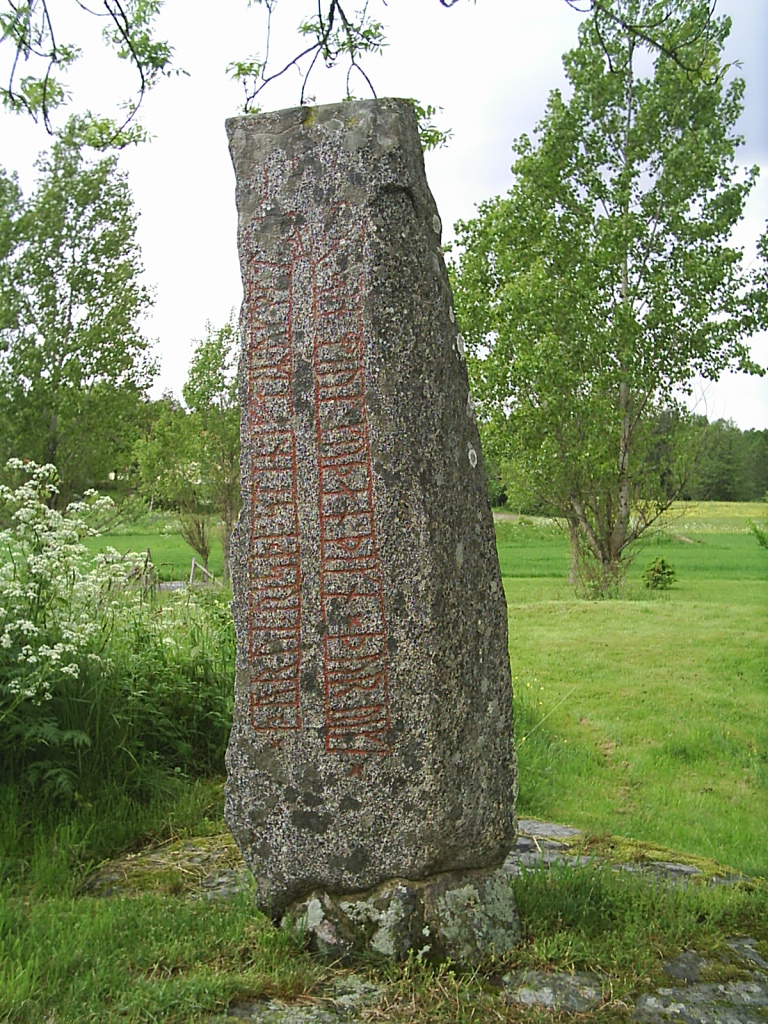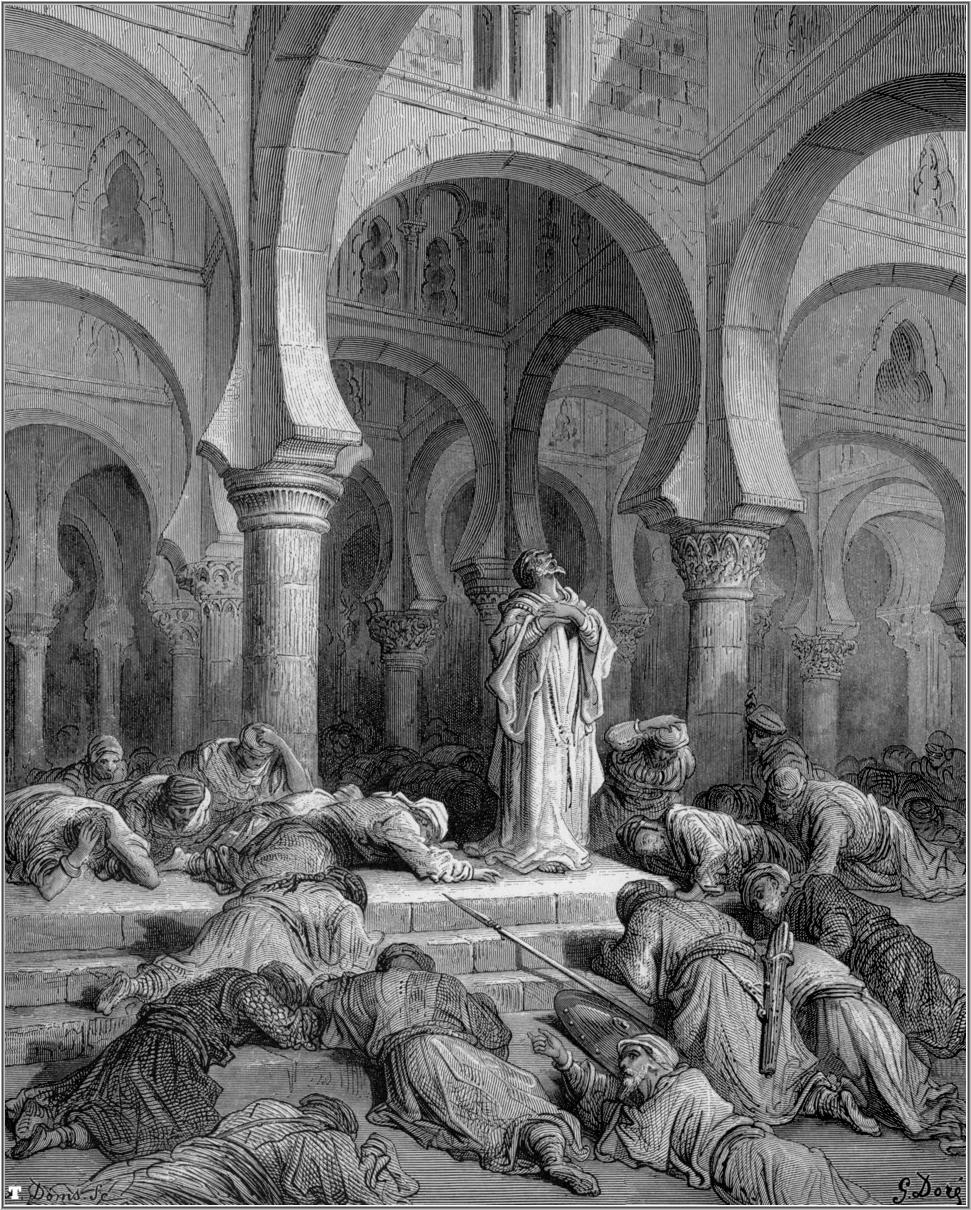|
Glavendrup Stone
The Glavendrup stone, designated as DR 209 by Rundata, is a runestone on the island of Funen in Denmark and dates from the early 10th century. It contains Denmark's longest runic inscription and ends in a curse. Description The runestone forms the end of a stone ship. There are other megaliths in the vicinity, including memorial stones with Latin characters from the early 20th century. In the stone ship, nine graves have been found, but they were all empty. The runestone was discovered when sand was quarried in the area in 1794, and it was saved in 1808 by the archaeologist Vedel Simonssen when stonemasons wanted to buy it. The last restoration was made in 1958, and the mound it is standing on is modern. Ragnhild who ordered the stone also ordered the Tryggevælde Runestone (DR 230) from the runemaster Soti. The runic inscription is classified as being in runestone style RAK. This is the classification for inscriptions with text bands with straight ends that do not have attach ... [...More Info...] [...Related Items...] OR: [Wikipedia] [Google] [Baidu] |
Thegn
In Anglo-Saxon England, thegns were aristocratic landowners of the second rank, below the ealdormen who governed large areas of England. The term was also used in early medieval Scandinavia for a class of retainers. In medieval Scotland, there were local officials known as thanes. Etymology The Old English (, "man, attendant, retainer") is cognate with Old High German and Old Norse ("thane, franklin, freeman, man"). The thegn had a military significance, and its usual Latin translation was , meaning soldier, although was often used. ''An Anglo-Saxon Dictionary'' describes a thegn as "one engaged in a king's or a queen's service, whether in the household or in the country". It adds: "the word ... seems gradually to acquire a technical meaning, ... denoting a class, containing several degrees", but what remained consistent throughout was its association with military service. Origins The precursor of thegn was the ''gesith'', the companion of the king or great lor ... [...More Info...] [...Related Items...] OR: [Wikipedia] [Google] [Baidu] |
Sweden
Sweden, formally the Kingdom of Sweden,The United Nations Group of Experts on Geographical Names states that the country's formal name is the Kingdom of SwedenUNGEGN World Geographical Names, Sweden./ref> is a Nordic countries, Nordic country located on the Scandinavian Peninsula in Northern Europe. It borders Norway to the west and north, Finland to the east, and is connected to Denmark in the southwest by Øresund Bridge, a bridgetunnel across the Öresund. At , Sweden is the largest Nordic country, the third-largest country in the European Union, and the List of European countries by area, fifth-largest country in Europe. The Capital city, capital and largest city is Stockholm. Sweden has a total population of 10.5 million, and a low population density of , with around 87% of Swedes residing in urban areas in the central and southern half of the country. Sweden has a nature dominated by forests and a large amount of lakes, including List of largest lakes of Europ ... [...More Info...] [...Related Items...] OR: [Wikipedia] [Google] [Baidu] |
Saleby Runestone
The Saleby Runestone, designated as Vg 67 in the Rundata catalog, was originally located in Saleby, Västra Götaland County, Sweden, which is in the historic province of Västergötland, and is one of the few runestones that is raised in memory of a woman. Description The runic inscription and is classified as being in runestone style RAK. This is the classification for inscriptions where the runic bands do not have any serpent or beast heads at the ends, and is considered to be the oldest style. The Saleby Runestone was discovered in 1794 within the walls of the church of Saleby and then moved to its current location near Dagsnäs Castle. The stone is 2.7 metres in height and about 0.45 meters in width. The runic text states that the stone was raised by Freysteinn as a memorial to his wife Þóra, who is described as being "the best of her generation." The inscription ends with a curse on anyone who destroys the memorial. A similar curse also appears on the Glemminge stone in S ... [...More Info...] [...Related Items...] OR: [Wikipedia] [Google] [Baidu] |
Glemminge Stone
The Glemminge stone or DR 338 is a Viking Age runestone engraved in Old Norse with the Younger Futhark runic alphabet. It is found in the wall of Glimminge church in Scania, in Ystad Municipality in Sweden. The style of the runestone is the runestone style RAK.Scandinavian Runic-text Database - . The inscription ends with a curse similar to the ones found on the in , |
Sønder Vinge Runestone 2
The Sønder Vinge stone 2 or DR 83 is a Viking Age runestone engraved in Old Norse with the Younger Futhark runic alphabet. The stone is in granite and was discovered in 1866 as a corner stone of Sønder Vinge Church, positioned with the runic inscription outwards.Danske Runeindskrifter, Nationalmuseet accessed December 28, 2020. It is presently located in the porch of the church. It is probably from the period 970-1020 due to runic and linguistic features. It is 180 cm tall, 132 cm wide and 35 cm thick. Parts of the runic inscription have eroded which makes some runes hard to read. The style of the runestone is the [...More Info...] [...Related Items...] OR: [Wikipedia] [Google] [Baidu] |
Velanda Runestone
The Velanda Runestone ( sv, Velandastenen), designated as Vg 150 in the Rundata catalog, is a runestone dated to the late tenth century or the early eleventh century that is located in the village of Velanda, Trollhättan Municipality, Västra Götaland County, Sweden, which is in the historic province of Västergötland. It was discovered around 1910 by a farmer named Jacobsson. Description The Velanda Runestone is inscribed in Old Norse with the Younger Futhark. Above the arch of the runic text band is the outline of an eagle's head facing to the left. The stone was raised by a woman named Þyrvé in memory of her husband Ögmundr. The runic inscription states that he was ''miok goðan þegn'' or "a very good thegn". About fifty other runestones refer to the deceased being a thegn. Of these, four use exactly the same phrase, ''miok goðan þegn'': Vg 73 in Synnerby, Vg 108 in Tängs gamla, Vg 137 in Sörby, and DR 99 in Bjerregrav. The exact role of thegns in southern Sweden i ... [...More Info...] [...Related Items...] OR: [Wikipedia] [Google] [Baidu] |
Rök Runestone
The Rök runestone ( sv, Rökstenen; Ög 136) is one of the most famous runestones, featuring the longest known runic inscription in stone. It can now be seen beside the church in Rök, Ödeshög Municipality, Östergötland, Sweden. It is considered the first piece of written Swedish literature and thus it marks the beginning of the history of Swedish literature.Gustafson, Alrik, Svenska litteraturens historia, 2 volums (Stockholm, 1963). First published as A History of Swedish Literature (American-Scandinavian Foundation, 1961). Chapter 1. About the stone The , tall stone was discovered built into the wall of a church in the 19th century and removed from the church wall a few decades later. The church was built in the 12th century, and it was common to use rune stones as building material for churches. The stone was probably carved in the early 9th century, judging from the main runic alphabet used ("short-twig" runes) and the form of the language. It is covered with run ... [...More Info...] [...Related Items...] OR: [Wikipedia] [Google] [Baidu] |
Sønder Kirkeby Runestone
The Sønder Kirkeby Runestone, listed as runic inscription DR 220 in the Rundata catalog, is a Viking Age memorial runestone that was discovered in Sønder Kirkeby, which is located about 5 kilometers east of Nykøbing Falster, Denmark. Description The Sønder Kirkeby Runestone has been known to Danish antiquarians since 1802 when it was discovered in the northwest wall of the church in Sønder Kirkeby. Before the historical significance of runestones was understood, they were often reused as building materials in the construction of roads, bridges, and buildings. The stone was removed by the Danish Antiquarian Commission in 1811, and it is currently on display at the National Museum of Denmark in Copenhagen. The runestone, which is 0.79 meters in height, is known locally as the ''Sønder Kirkeby-stenen''. The inscription consists of four lines of runic text in the younger futhark that are below the image of a ship. Portions of the inscription and the ship image are damaged, which ... [...More Info...] [...Related Items...] OR: [Wikipedia] [Google] [Baidu] |
DR 110
DR 110, or the Virring stone, is a runestone made of granite that measures in height, in width and in thickness. It is written in Old East Norse in the Younger Futhark, and the runestone style is in a form called RAK. It was discovered in 1865 being used as the threshold for the church porch in the church of Virring in Denmark.Danske Runeindskrifter - entry for Virring-sten. It is tentatively dated to the period 900-960 based on the runes and the language. It had been severely worn down so many runes are missing. A peculiarity in the inscription is the m rune which has a rounded top( [...More Info...] [...Related Items...] OR: [Wikipedia] [Google] [Baidu] |
Invocation
An invocation (from the Latin verb ''invocare'' "to call on, invoke, to give") may take the form of: *Supplication, prayer or spell. *A form of possession. *Command or conjuration. * Self-identification with certain spirits. These forms are described below, but are not mutually exclusive. See also Theurgy. Supplication or prayer As a supplication or prayer, an invocation implies calling upon God, a god, goddess, or person. When a person calls upon God, a god, or goddess to ask for something (protection, a favour, or his/her spiritual presence in a ceremony) or simply for worship, this can be done in a pre-established form or with the invoker's own words or actions. An example of a pre-established text for an invocation is the Lord's Prayer. All religions in general use invoking prayers, liturgies, or hymns; see for example the mantras in Hinduism and Buddhism, the Egyptian ''Coming Out by Day'' (aka ''Book of the Dead''), the Orphic Hymns and the many texts, still ... [...More Info...] [...Related Items...] OR: [Wikipedia] [Google] [Baidu] |






